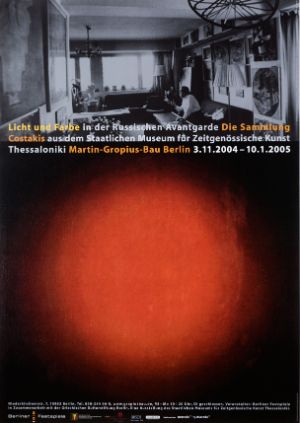Exhibition
Colour and Light in the Russian Avant-Garde
The Costakis Collection

Poster of the exhibition “Light and Colour in the Russian Avant-Garde. The Costakis Collection” Design: Steenbrink Vormgeving, Berlin
An exhibition of the State Museum of Contemporary Art Thessaloniki“In their search for the rhythms of the world through the pictorial, the painters of the Russian avant-garde brought out a new light, no longer the external light of the sun, but rather the internal light that is an emanation of the world’s energies.”
Jean-Claude Marcadé
George Costakis is known as one of the most important art collectors of the 20th century. In Russia during the 1950s and 60s he purchased works of Russian avant-garde artists in whom no one seemed to be interested at the time. Today the Costakis Collection of the State Museum of Contemporary Art in Thessaloniki counts as one of the most outstanding collections of art.
Berlin is the only station in Germany for this exhibition, which comprises some 320 works, as well as archive material, of around 50 artists. Some of the works will be on public display for the first time in this exhibition. The exhibition was curated by the Director of the State Museum in Thessaloniki, Professor Miliades Papanikolaou.
All of the different movements within the Russian avant-garde from 1900 to 1943 are represented in the collection. The exhibition does not consider the artworks in the light of their affiliation with one movement or another, but rather focuses on the preoccupation of the Russian avant-garde artists with light and colour and their importance for the development of art in the 20th century. It is divided into ten chapters:
1. Black – 2. Auto-Luminous – 3. The Imaginary Colour – 4. The Liberation of Colour – 5. The Domination of Colour – 6. The Study of Colour – 7. Colour in Decoration, Colour in Production – 8. Light and Science, Light and Technology – 9. Fading – 10. White
The consideration of monochrome works is followed by that of works liberated from colour; the study of works preoccupied with light in a cosmic and metaphysical context leads into works marked by the influence of electricity, photography and film. Archive material, manuscripts, books, photographs and films complement the exhibition.
Among the artists particularly featured are Alexander Drevin, Ksenia Ender, Ivan Kliun, Gustav Klutsis, Ivan Kudriashev, El Lissitzky, Kazimir Malevich, Solomon Nikritin, Liubov Popova, Alexander Rodchenko, Olga Rozanova, Antonina Sofronova, Vladimir Tatlin, Ilya Chashnik, Nadezhda Udaltsova and Konstantin Vialov.
Miltiades Papanikolaou, Professor of Art History at the Aristotle University in Thessaloniki and Director of the State Museum of Contemporary Art in Thessaloniki (SMCA) is the principal curator of the exhibition, supported by an international committee of experts: John E. Bowlt, Charlotte Douglas, Nicoletta Misler and Maria Tsantsanoglou, who is also responsible for the coordination.
The publishers Dumont Verlag have published a trilingual catalogue (German – English – Greek) with some 450 pages, containing essays by authors from more than nine countries, including Snejanka Bauer, Lutz Becker, John Bowlt, S.O. Chan-Magomedow, Charlotte Douglas, Maria Ender, Olga Fota & Maria Kokkori, Konstantin Istomin, Aliki Kostaki, Christina Lodder, Jean-Claude Marcadé, Nicoletta Misler, Miltiades Papanikolaou, Ada Raev, Alexandra Schazkich, Maria Tsantsanoglou, Margareta Tillberg and Syrago Tsiara.
The catalogue also contains theoretical treatments and texts by the Russian artists. It gives an insight into the study materials and learning programmes that were used in art schools at the time and shows the importance that was given to light and colour.
“Both exhibition and catalogue were designed in the framework of an evolutionary, historical perspective, recording the different stages in the approach to colour and light, the gradual liberation from the function of representation and the final independence of pure shape and colour.”
Miltiades Papanikolaou, principal curator of the exhibition
On the History of the Collection
George Costakis worked for almost four decades at the Canadian Embassy in Moscow. His passion for collecting works of the Russian avant-garde from 1900-1943 began in earnest in 1946. In the 1970s his flat in a high-rise building in Moscow became a kind of private museum and meeting place for artists, intellectuals and collectors, who were able to discover both famous and unknown pioneers of the Russian avant-garde, whose work had a decisive influence on artistic developments in Western Europe, including Wassily Kandinsky, Kazimir Malevich, Alexander Rodchenko or Liubov Popova.
In 1977 Costakis decided to leave the Soviet Union and return to Greece, the land of his forefathers. He had to leave behind a small part of his collection in Moscow. When Costakis died in 1990, his collection disappeared from the public eye until the Greek government bought it in the year 2000.
In the wake of Thessaloniki’s year as European Cultural Capital in 1977, the world-famous collection was given its own exhibition space in Thessaloniki, the State Museum of Contemporary Art.
“The Costakis Collection must be regarded as a magnificent monument to one of the greatest achievements in the history of Russian civilization.”
John Bowlt, Professor at the University of Los Angeles
Organizer: Berliner Festspiele in cooperation with the Greek Cultural Foundation Berlin. An exhibition of the State Museum of Contemporary Art Thessaloniki.
Patronage: Horst Köhler, Federal President of the Republic of Germany, Heinz Fischer, Federal President of the Republic of Austria, Kostis Stefanopoulos, President of the Republic of Greece
Curators: Miltiades Papanikolaou, Thessaloniki with Maria Tsantsanoglou, Thessaloniki
Venues: Berlin: Martin-Gropius-Bau, Vienna: Museum Moderner Kunst Stiftung Ludwig, Thessaloniki: Staatliches Museum für Zeitgenössische Kunst